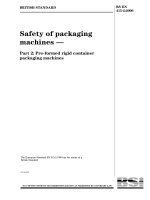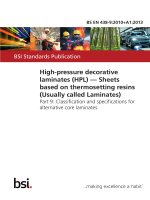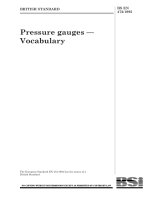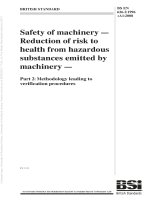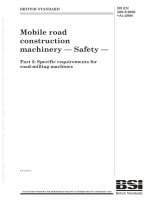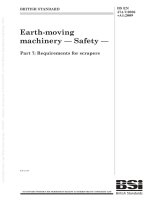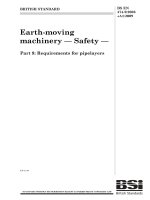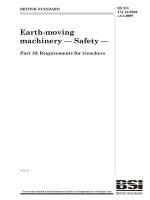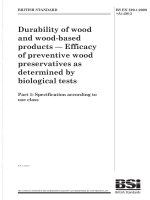Bsi bs en 00792 10 2000 + a1 2008
Bạn đang xem bản rút gọn của tài liệu. Xem và tải ngay bản đầy đủ của tài liệu tại đây (430.6 KB, 24 trang )
BRITISH STANDARD
Hand-held non-electric
power tools Ð Safety
requirements Ð
Part 10: Compression power tools
ICS 25.140.01
NO COPYING WITHOUT BSI PERMISSION EXCEPT AS PERMITTED BY COPYRIGHT LAW
|
|
|
|
|
|
|
|
|
|
|
|
|
|
|
|
|
|
|
|
|
|
|
|
|
|
|
|
|
|
|
|
|
|
|
|
|
|
|
|
|
|
|
|
|
|
|
|
|
|
|
|
|
|
|
|
|
|
|
|
|
|
|
|
|
|
|
|
|
|
|
|
|
|
|
|
|
|
|
|
|
|
|
|
|
|
|
|
|
|
|
|
|
|
|
|
|
|
|
|
|
|
|
|
|
|
|
|
|
|
|
|
|
|
|
|
|
|
|
|
|
|
|
|
|
|
|
|
|
BS EN
792-10:2000
+A1:2008
BS EN 792-10:2000+A1:2008
National foreword
This British Standard is the UK implementation of EN 792-10:2000+A1:2008.
It supersedes BS EN 792-10:2000 which is withdrawn.
The start and finish of text introduced or altered by amendment is indicated
in the text by tags. Tags indicating changes to CEN text carry the number of
.
the CEN amendment. For example, text altered by CEN amendment
A1 is
indicated by !".
The UK participation in its preparation was entrusted by Technical
Committee MCE/8, Compressors, pneumatic tools, pneumatic machines and
vacuum technology to Panel MCE/8/-/2, h
H and-held, non-electric power tools - safety/
A list of organizations represented on this committee can be obtained on request
to its secretary.
This publication does not purport to include all the necessary provisions of
a contract. Users are responsible for its correct application.
Compliance with a British Standard cannot confer immunity from
legal obligations.
This British Standard
was published under the
authority of the Standards
Committee and comes into
effect on 15 August 2000
© BSI 2009
ISBN 978 0 580 61940 3
Amendments/corrigenda issued since publication
Date
Comments
30 June 2009
Implementation of CEN amendment A1:2008
EUROPEAN STANDARD
EN 792-10:2000+A1
NORME EUROPÉENNE
EUROPÄISCHE NORM
September 2008
ICS 25.140.10; 25.140.99
Supersedes EN 792-10:2000
English Version
Hand-held non-electric power tools - Safety requirements - Part
10: Compression power tools
Machines portatives à moteur non électrique - Prescriptions
de sécurité - Partie 10: Machines portatives à compression
Handgehaltene nicht-elektrisch betriebene Maschinen Sicherheitsanforderungen - Teil 10: Maschinen zum
Pressen
This European Standard was approved by CEN on 26 May 2000 and includes Amendment 1 approved by CEN on 26 July 2008.
CEN members are bound to comply with the CEN/CENELEC Internal Regulations which stipulate the conditions for giving this European
Standard the status of a national standard without any alteration. Up-to-date lists and bibliographical references concerning such national
standards may be obtained on application to the CEN Management Centre or to any CEN member.
This European Standard exists in three official versions (English, French, German). A version in any other language made by translation
under the responsibility of a CEN member into its own language and notified to the CEN Management Centre has the same status as the
official versions.
CEN members are the national standards bodies of Austria, Belgium, Bulgaria, Cyprus, Czech Republic, Denmark, Estonia, Finland,
France, Germany, Greece, Hungary, Iceland, Ireland, Italy, Latvia, Lithuania, Luxembourg, Malta, Netherlands, Norway, Poland, Portugal,
Romania, Slovakia, Slovenia, Spain, Sweden, Switzerland and United Kingdom.
EUROPEAN COMMITTEE FOR STANDARDIZATION
COMITÉ EUROPÉEN DE NORMALISATION
EUROPÄISCHES KOMITEE FÜR NORMUNG
Management Centre: rue de Stassart, 36
© 2008 CEN
All rights of exploitation in any form and by any means reserved
worldwide for CEN national Members.
B-1050 Brussels
Ref. No. EN 792-10:2000+A1:2008: E
BS EN 792-10:2000+A1:2008
EN 792-10:2000+A1:2008 (E)
Contents
Page
Foreword..............................................................................................................................................................3
Introduction .........................................................................................................................................................4
1
Scope ......................................................................................................................................................4
2
Normative references ............................................................................................................................5
3
3.1
3.2
Terms and definitions ...........................................................................................................................6
General terms and definitions ..............................................................................................................6
Terms and definitions related to compression power tools .............................................................7
4
List of hazards........................................................................................................................................8
5
5.1
5.2
5.3
5.4
5.5
5.6
5.7
Safety requirements and measures .....................................................................................................9
Mechanical safety ..................................................................................................................................9
Thermal safety........................................................................................................................................9
Noise .......................................................................................................................................................9
Vibration ...............................................................................................................................................10
Materials and substances processed, used or exhausted ..............................................................10
Ergonomics ..........................................................................................................................................10
Safety related measures and means..................................................................................................11
6
6.1
6.2
Information for use ..............................................................................................................................11
Marking, signs and written warnings.................................................................................................11
Instruction for use ...............................................................................................................................12
7
7.1
7.2
7.3
7.4
Verification ...........................................................................................................................................13
Noise .....................................................................................................................................................13
Vibration ...............................................................................................................................................14
Unintentional start ...............................................................................................................................14
Structure of verification ......................................................................................................................15
Annex A (informative) Examples of compression power tools covered by this part.................................16
Annex B (informative) Symbols for labels and signs ....................................................................................17
Annex ZA (informative) !Relationship between this European Standard and the Essential
Requirements of EU Directive 98/37/EC".......................................................................................18
Annex ZB (informative) !Relationship between this European Standard and the Essential
Requirements of EU Directive 2006/42/EC"...................................................................................19
Bibliography ......................................................................................................................................................20
2
BS EN 792-10:2000+A1:2008
EN 792-10:2000+A1:2008 (E)
Foreword
This document (EN 792-10:2000+A1:2008) has been prepared by Technical Committee CEN/TC 255 "Handheld, non-electric power tools - Safety", the secretariat of which is held by SIS.
This European Standard shall be given the status of a national standard, either by publication of an identical
text or by endorsement, at the latest by March 2009 and conflicting national standards shall be withdrawn at
the latest by December 2009.
This European Standard has been prepared under a mandate given to CEN by the European Commission
and the European Free Trade Association, and supports essential requirements of EU Directive(s).
!For relationship with EU Directive(s), see informative Annexes ZA and ZB, which are integral parts of this
document."
This document includes Amendment 1, approved by CEN on 2008-07-26.
This document supersedes EN 792-10:2000.
The start and finish of text introduced or altered by amendment is indicated in the text by tags ! ".
The standard has been created in close co-operation with CENELEC/TC 61F with the aim of achieving
requirements for mechanical safety in the EN 50144 series, which are similar for hand-held electric and nonelectric power tools.
The annexes to this part of the standard are:
Annex A (informative) Examples of power tools covered by this part
Annex B (informative) Labels, signs and tags
!Annexes ZA and ZB" (informative) Clauses of this European Standard addressing essential
requirements or other provisions of EU Directives.
This standard also contains a Bibliography.
According to the CEN/CENELEC Internal Regulations, the national standards organizations of the following
countries are bound to implement this European Standard: Austria, Belgium, Bulgaria, Cyprus, Czech
Republic, Denmark, Estonia, Finland, France, Germany, Greece, Hungary, Iceland, Ireland, Italy, Latvia,
Lithuania, Luxembourg, Malta, Netherlands, Norway, Poland, Portugal, Romania, Slovakia, Slovenia, Spain,
Sweden, Switzerland and United Kingdom.
3
BS EN 792-10:2000+A1:2008
EN 792-10:2000+A1:2008 (E)
Introduction
This European standard is a type C standard as stated in EN 1070.
The machinery concerned and the extent to which hazards, hazardous situations and events are covered are
indicated in the scope of this standard.
When provisions of this type C standard are different from those which are stated in type A or B standards, the
provisions of this type C standard take precedence over the provisions of other standards, for machines that
have been designed and built according to the provisions of this type C standard.
The European Standard, EN 792, consists of a number of independent parts for individual types of hand-held
non-electric power tools.
Other EN standards deal with safety rules for hand-held power tools used in e.g. the following fields:
agriculture and forestry such as chain saws, hedge-trimmers, brush cutters, grass trimmers
construction and building such as cutting-off power tools, concrete vibrators
food industry, such as fowl secateurs, sheep shears.
Endeavours have been made to achieve co-ordination with the relevant Technical Committees so that the
safety requirements are compatible.
This standard is divided in the following parts:
Part 1 - Assembly power tools for non-threaded mechanical fasteners (former part 14)
Part 2 - Cutting-off and crimping power tools (former part 15)
Part 3 - Drills and tappers
Part 4 - Non rotary percussive power tools
Part 5 - Rotary, percussive power drills
Part 6 - Assembly power tools for threaded fasteners
Part 7 - Grinders
Part 8 - Sanders and polishers
Part 9 - Die grinders
Part 10 - Compression power tools
Part 11 - Nibblers and shears
Part 12 - Small circular, small oscillating and reciprocating saws
Part 13 - Fastener driving tools
Certain parts of EN 792 cover hand-held non-electric power tools, driven by internal combustion engines
powered by gaseous or liquid fuel. In these parts, the safety aspects relating to internal combustion engines
are found in a normative annex.
The parts are type C standards and refer to pertinent European Standards of type A and B where such
standards are applicable.
1
Scope
The standard EN 792 applies to hand-held non-electric power tools driven by rotary or linear motors, powered
by compressed air, hydraulic fluid and intended to be used by one operator and supported by:
4
BS EN 792-10:2000+A1:2008
EN 792-10:2000+A1:2008 (E)
the operator's hand or hands
a suspension, e.g. a balancer.
This part, EN 792-10, applies to hand-held non electric compression power tools with yoke, e.g. for squeeze
riveting, punching, shaping, pressing and cutting of metal, plastics or other materials.
This part lists the significant hazards caused by such power tools and specifies safety requirements valid for
different aspects of safety during their foreseeable lifetime.
Power tools, all of them with a yoke, covered by this part of the standard:
crimping tools,
collar splitters,
power tools for metal forming (edge formers, folding tools, swagers),
nut splitter heads,
presses,
punches,
squeeze riveters,
cutting power tools with parallel knives.
Special requirements and modifications on a hand-held power tool for the purpose of mounting it in a fixture
are not covered by this part.
NOTE
2
At the date of publication no compression power tools driven by internal combustion engines are known.
Normative references
This European Standard incorporates by dated or undated reference, provisions from other publications.
These normative references are cited at the appropriate places in the text and the publications are listed
hereafter. For dated references, subsequent amendments to or revisions of any of the publications referred to
in this European Standard are valid only when they are incorporated in this standard by amendment or
revision. For undated references the latest edition of the publication referred to, applies (including
amendments).
EN 292-1:1991, Safety of machinery - Basic concepts, general principles for design – Part 1: Basic
terminology, methodology
EN 292-2:1991, Safety of machinery - Basic concepts, general principles for design – Part 2: Technical
principles and specifications
EN 563, Safety of machinery - Temperatures of touchable surfaces - Ergonomics data to establish
temperature limit values for hot surfaces
EN 574, Safety of machinery - Two-hand control devices - Functional aspects - Principles for design
EN 614-1, Safety of machinery - Ergonomic design principles – Part 1: Terminology and general principles
EN 1070, Safety of machinery - Terminology
5
BS EN 792-10:2000+A1:2008
EN 792-10:2000+A1:2008 (E)
EN 1127-1, Safety of machinery - Fire and explosions – Part 1: Explosion, prevention and protection
EN 12096, Mechanical vibration - Declaration and verification of vibration emission values
EN ISO 4871, Acoustics - Declaration and verification of noise emission values of machinery and equipment
(ISO 4871:1996)
!EN ISO 15744:2008, Hand-held non-electric power tools – Noise measurement code – Engineering
method (grade 2) (ISO 15744:2002)"
EN 28662-1, Hand-held portable power tools - Measurement of vibration at the handle – Part 1: General
(ISO 8662-1:1988)
ISO 3857-3, Compressors, Pneumatic tools and machines, Vocabulary – Part 3: Pneumatic tools and
machines
ISO 5391, Pneumatic tools and machines - Vocabulary
3
Terms and definitions
For the purposes of this part of the standard, the following terms and definitions apply:
3.1
General terms and definitions
3.1.1
hand-held power tool
machine driven by rotary or linear motors powered by compressed air, hydraulic fluid, gaseous or liquid fuel,
electricity or stored energy (e.g. by a spring) to do mechanical work and so designed that the motor and the
mechanism form an assembly that can easily be brought to its place of operation. The hand-held power tool is
operated by one or two hands.
NOTE: Hand-held power tools driven by compressed air or gas are called pneumatic tools. Hand-held power
tools driven by hydraulic liquid are called hydraulic tools.
3.1.2
inserted tool
tool inserted in the hand-held power tool to perform the intended work
3.1.3
service tool
tool intended for performing maintenance or service on the hand-held power tool
3.1.4
control device
device to start and stop the hand-held power tool or to change the direction of the rotation or to control the
functional characteristics such as speed and power
3.1.5
maximum operating pressure
maximum pressure that a hand-held power tool may be operated at, as specified by the manufacturer
6
BS EN 792-10:2000+A1:2008
EN 792-10:2000+A1:2008 (E)
3.2
Terms and definitions related to compression power tools
3.2.1
compression tool
power tool, without a rotary action that delivers an axial force in one stroke without percussion when actuated.
The power tool incorporates the compression means and a yoke which absorbs the reaction forces. The force
can be directed onto an inserted rivet set, or punch, forming dies and similar tooling.
3.2.2
collar splitter
compression tool for splitting a collar by pressing and cutting
3.2.3
crimping tool
power tool with a mechanism to permanently fasten by crimping or clinching a connection element, e.g. to a
cable or a hose
3.2.4
punch
power tool for marking by indentation of various materials
3.2.5
nut splitter head
compression tool for splitting a nut by pressing and cutting
3.2.6
squeeze riveter
compression tool, where the force is directed onto an inserted rivet set
3.2.7
swager
compression tool for metal forming, e.g. a joggled joint
For other terms, see EN 1070 and also ISO 3857-3 and ISO 5391.
For examples of compression power tools see annex A.
7
BS EN 792-10:2000+A1:2008
EN 792-10:2000+A1:2008 (E)
4
List of hazards
The following hazards can occur in the use of compression power tools.
Hazard type
Reference to safety requirement
By design or
guarding
Information
for use
4.1 Mechanical hazards
- crushing
5.1.3, 5.7.3
- cutting
5.1.1
- friction or abrasion hazard
5.1.1
- loss of stability
5.1.2
6.2.2
- whipping hose
- ejection from high pressure hydraulic systems
5.1.4
- hose and hose coupling specifications
6.2.2
4.2 Electrical hazards
6.2.2
4.3 Thermal hazards
5.2
- explosions
5.2
- health damage due to hot or cold surfaces
5.2
4.4 Hazards caused by noise
5.3
6.2.2
4.5 Hazards generated by vibration
5.4
6.2.2
4.6 Hazards generated by materials and
substances processed, used or exhausted
- exhaust air
5.5.1
- lubricants
5.5.2
- hydraulic fluid
4.7 Hazards caused by neglecting ergonomic
principles
6.2.2
5.6.1, 5.6.2, 5.6.3,
- repetitive strain injuries
- unsuitable postures
6.2.2
5.6.1
- inadequate grip design and tool balance
6.2.2
- neglected use of personal protection equipment
4.8 Hazards caused by failure of energy supply
- unexpected return of energy supply after a
breakdown
6.2.2
- incorrect hydraulic fluid flow and outlet pressure
6.2.2
4.9 Hazards caused by missing and/or incorrectly
positioned safety related means
8
- start and stop device
5.7.1
- unintentional start
5.7.2
6.2.2
BS EN 792-10:2000+A1:2008
EN 792-10:2000+A1:2008 (E)
5
Safety requirements and measures
5.1
Mechanical safety
5.1.1
Surfaces, edges and corners
Accessible parts of the compression power tools, except the inserted tool, shall not have sharp edges or
angles or rough or abrasive surfaces, see 3.1 of EN 292-2:1991.
5.1.2
Supporting surface and stability
Compression power tools shall be so designed that they can be laid aside and remain in stable position on a
plane surface.
5.1.3
Position of handles
Handles shall be designed to be clear from the compression area and be remotely positioned from the
compression mechanism.
5.1.4
High pressure ejection
Hydraulic systems of the power tools shall be enclosed so as to give protection against high pressure fluid
ejection.
5.2
Thermal safety
Surface temperatures of parts of the power tools which are held during use or could be inadvertently touched
shall follow the provisions of EN 563.
NOTE
The limit values for low temperatures are studied by CEN/TC 122.
Power tools for use in potentially explosive atmospheres should comply with EN 1127-1. However because
the suitability of a power tool for use in potentially explosive atmospheres will depend not only on the power
tool but the inserted tool and the workpiece, it is not possible to give any detailed advice in this standard.
5.3
Noise
5.3.1
General
The emission of noise from a hand-held power tool shall be kept as low as possible.
The noise emission from using hand-held power tools emanates from three main sources:
the hand-held power tool itself,
the inserted tool,
the workpiece.
NOTE
5.3.2
Generally, the manufacturer has no possibility of influencing the noise emitted by the processed workpiece.
Noise emitted by the hand-held power tool
The noise emitted by the hand-held power tool itself can be divided into:
noise from the motor,
9
BS EN 792-10:2000+A1:2008
EN 792-10:2000+A1:2008 (E)
noise from exhaust air at pneumatic tools,
vibration induced noise.
The noise from the exhaust of air is one major contributor of noise from pneumatic driven hand-held power
tools. A silencer of good design will reduce this noise.
The principles contained in EN ISO 11688-1 should be followed to reduce the noise emitted by the power tool.
NOTE
The exhaust air can also be piped away in a hose away from the operator, however this method has
limitations in practice.
Vibration induced noise can be reduced by use of acoustic isolation and vibration damping.
5.4
Vibration
Vibration at the handle of a hand-held power tool shall be kept as low as possible.
The principles contained in CR 1030-1 should be followed to reduce the vibration emitted by the power tool.
5.5
5.5.1
Materials and substances processed, used or exhausted
Exhaust air
For compression power tools driven with compressed air the exhaust air shall be directed in such a way that it
cannot cause a hazard to the operator and so that any secondary effects are minimized. e.g. blowing the dust
and reflected air from the workpiece onto the operator.
5.5.2
Lubricants
Lubricants for compression power tools, specified by the manufacturer, shall not cause hazards to the
operator or the environment.
5.6
5.6.1
Ergonomics
Design of the handle
Handles and other parts used for gripping the power tool shall be designed to ensure that the operator is able
to grip the compression power tool correctly and to perform the expected work. Handles shall suit the
functional anatomy of the hand and the dimensions of the hands of the operator population. See 3.6 of
EN 292-2:1991 and EN 614-1.
Power tools having a mass greater than 2 kg (including the inserted tool) shall be capable of being supported
by two hands whilst being lifted or operated.
The surface of the handle or of the part of the power tool being gripped by the operator shall permit ventilation
of the hand and give adequate friction.
5.6.2
Control device
The control device shall be adapted to the handle or to the part of the power tool being gripped by the
operator so that it can be held comfortably in the run position.
For compression power tools which are normally are started frequently and often used for precision works the
trigger force should be small.
10
BS EN 792-10:2000+A1:2008
EN 792-10:2000+A1:2008 (E)
For further information on trigger forces for control devices see EN 894-3:2000.
5.6.3
Suspension device
Provision shall be made, where appropriate, to enable the attachment to the compression power tool of a
suspension device. The fitting of a suspension device shall not introduce an additional hazard.
5.7
Safety related measures and means
5.7.1
Start and stop device
Compression power tools shall be equipped with a single control device to start or stop them. It shall be
arranged near the handle so that the operator can activate it without releasing the grip on the handles.
Each operation of the compression power tool shall be initiated by actuating the start and stop device which
shall return to the start position before a new or a continued operation can be initiated.
The start and stop device shall be in the stop position or immediately move to the stop position when the
compression power tool is connected to the energy supply.
5.7.2
Unintentional start
The start and stop device shall be so designed, positioned or guarded that the risk of unintentional start is
minimized. Verification shall be made according to clause 7.3.
5.7.3
Two-hand control
Two-hand control according to type 1 of EN 574 shall be required for compression power tools having a stroke
of more than 8 mm, if the power tool is designed to execute a complete stroke and where the stroke cannot
be interrupted by releasing the start and stop device.
6
6.1
Information for use
Marking, signs and written warnings
!Compression power tools shall be marked visibly, legibly and indelibly with the following minimum
particulars:
the business name and full address of the manufacturer and, where applicable, his authorized
representative;
designation of the machinery;
the CE Marking (see Annex III);
designation of series or type;
serial number, if any;
the year of construction, that is the year in which the manufacturing process is completed."
Compression power tools shall be permanently marked with a graphical symbol, stating that the operator's
instruction shall be read before work starts, according to annex B. Other graphical symbols that can be used
are shown in annex B.
11
BS EN 792-10:2000+A1:2008
EN 792-10:2000+A1:2008 (E)
6.2
Instruction for use
6.2.1
General
The instructions for use shall be drawn up by the manufacturer and contain:
operator's instruction,
maintenance instruction.
The operator's instructions shall be drawn up in according to 5.5.2 of EN 292-2:1991 and annex A, 1.7.4 and
2.2 of EN 292 2:1991. Concerning residual risks see 5.5 of EN 292-1:1991.
6.2.2
Operator's instruction
The operator's instruction shall include a description of the correct use of the compression power tool and
make reference to the appropriate inserted tools.
The operator's instruction shall state that any other use is forbidden.
Foreseeable misuse of the power tool, which experience has shown to occur, shall be warned against.
!The operator's instruction shall give information on airborne noise emissions:
the A-weighted emission sound pressure level at workstations, where this exceeds 70 dB (A); where this
level does not exceed 70 dB (A), this fact shall be indicated;
the peak C-weighted instantaneous sound pressure value at workstations, where this value exceeds
63 Pa (130 dB in relation to 20 µPa);
the A-weighted sound power level emitted by the machinery, where the A-weighted emission sound
pressure level at workstations exceeds 80 dB(A)."
!The operator's instruction shall give information on vibration total value in the handles, including
uncertainty of measurement."
The reference numbers of the applied standards for noise and vibration measurements shall be given.
The operator's instruction shall recommend the use of ear protectors.
Warnings shall be given:
that compression power tools are not generally insulated for coming into contact with electric power
sources;
that power tools shall not be used in explosive atmospheres unless specially designed for this purpose;
of the risk of a whipping compressed air hose.
Instructions shall be given:
that power tools shall be isolated from the energy source before changing the inserted tool;
that regular inspections for cracks and fissures in the compression mechanism and yoke shall be made;
release the start and stop device in the case of an interruption of the energy supply;
12
BS EN 792-10:2000+A1:2008
EN 792-10:2000+A1:2008 (E)
that only lubricants recommended by the manufacturer shall be used;
that only hydraulic fluids according to the manufacturer's instruction shall be used.
NOTE: It is recommended to check with the manufacturer if non-flammable fluids can be used.
to keep hands away from the compression mechanism and recommendation to hold the power tool with
both hands.
Information shall be given for hydraulic percussive power tools regarding the design and dimension of
couplings:
specification of the coupling,
specification of hoses with regard to pressure and flow,
maximum flow,
maximum inlet pressure,
maximum inlet temperature of the inlet fluid.
Requirements for power tools to be used in potentially explosive atmospheres see EN 1127-1.
6.2.3
Maintenance instruction
The maintenance instruction shall contain:
instruction to keep the power tool safe by regular maintenance;
information on when the regular maintenance shall be carried out; for instance after a specified time of
operation, a specified number of cycles/operations, a stated number of times per year;
instructions for disposal so as not to impose hazards to personnel and the environment;
!
the specifications of the spare parts to be used, when these affect the health and safety of operators."
7
Verification
7.1
Noise
Compliance with 5.3 and 6.2.2 shall be verified as follows:
An equivalent continuous A-weighted sound pressure level at workstation shall be measured, and stated
according to !EN ISO 15744:2008".
An A-weighted sound power level shall be measured and stated according to !EN ISO 15744:2008".
The noise emission values shall be declared according to EN ISO 4871.
13
BS EN 792-10:2000+A1:2008
EN 792-10:2000+A1:2008 (E)
7.2
Vibration
Compliance with 5.4 and 6.2.2 shall be verified as follows:
The vibration level at the handle of the compression power tool shall be measured and stated.
The vibration value shall be declared according to EN 12096.
7.3
Unintentional start
Compliance with 5.7.2 shall be verified as follows:
The compression power tool shall be connected to the energy supply and placed in any possible position and
pulled over the horizontal plane by its hose.
Operation of the start and stop device shall then not occur.
14
BS EN 792-10:2000+A1:2008
EN 792-10:2000+A1:2008 (E)
7.4
Structure of verification
Safety requirement
5.1.1
Visual check
Functional
check
Measurement
Reference to
clauses of this
standard or to
other
standards
X
Surfaces, edges and
angles
5.1.2
X
Stability
5.1.3
X
Position of handles
5.1.4
X
High pressure ejection
5.2
X
EN 563
X
!EN ISO
15744:2008"
X
EN 28662-1
Thermal safety
5.3
Noise
5.4
Vibration
5.5.2
X
Dust
5.6.1
X
Handle
5.6.2
X
X
Control device
5.6.3
X
Suspension device
5.7.1
X
Start and stop device
5.7.2
X
X
clause 7.3
X
X
EN 574
Unintentional start
5.7.3
Two-hand control
15
BS EN 792-10:2000+A1:2008
EN 792-10:2000+A1:2008 (E)
Annex A
(informative)
Examples of compression power tools covered by this part
E squeeze riveter
F riveuse à compression
D Nietpressmaschine
E nut splitter head
F presses
D Mutternsprengmaschine
E: folding tool, swager
F machine de pliage
D Faltmaschine
E: crimping tool
F:machine de sertissage
D: Maschine zum Quetschen
E punch (with a yoke)
F machine à poinconner les trous
D Lochstanze
E cutter
F machine de découpe
D Schneider Zange
16
BS EN 792-10:2000+A1:2008
EN 792-10:2000+A1:2008 (E)
Annex B
(informative)
Symbols for labels and signs
Symbol
Significance
Colours
B.1
The operator's instruction
must be read before work
starts
Background: blue
Hearing protection must be
worn
Background: blue
ISO 3864
Symbol: white
EN 61 310-1
EN 61 310-2
B.2
Corresponding
standard
Symbol: white
17
BS EN 792-10:2000+A1:2008
EN 792-10:2000+A1:2008 (E)
Annex ZA
(informative)
!Relationship between this European Standard and the Essential
Requirements of EU Directive 98/37/EC
This European Standard has been prepared under a mandate given to CEN by the European Commission
and the European Free Trade Association to provide a means of conforming to Essential Requirements of the
New Approach Directive 98/37/EC, amended by 98/79/EC on machinery.
Once this standard is cited in the Official Journal of the European Communities under that Directive and has
been implemented as a national standard in at least one Member State, compliance with the clauses of this
standard confers, within the limits of the scope of this standard, a presumption of conformity with the
corresponding Essential Requirements of that Directive except ER 1.5.7 and associated EFTA regulations.
WARNING — Other requirements and other EU Directives may be applicable to the product(s) falling within
the scope of this standard."
18

